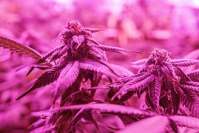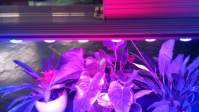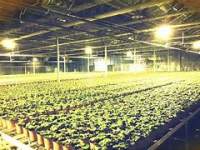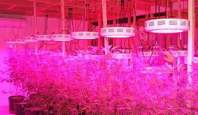Is the LED plant light for hemp the right choice?
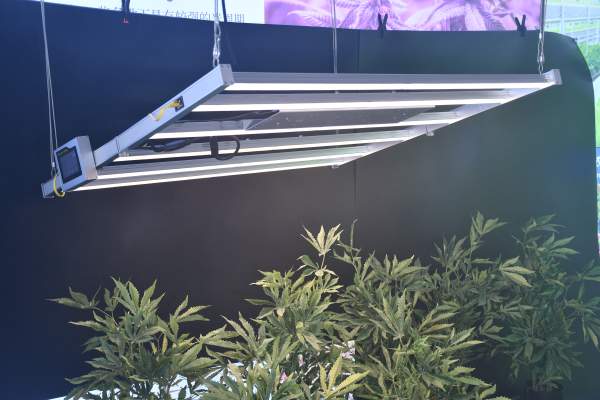
LED plant growth lights are now powerful enough and have sufficient spectrum, and are considered to be the ideal choice for cannabis plant growth lights. Using the correct umols and PAR values, LED grow lights will provide larger and thicker results than HID or high pressure sodium lights.
HPS lamps (high pressure sodium lamps) have been a confident leader in the cannabis lighting system market for decades, and although other technologies exist, they are unlikely to change their status. We will carefully study the differences between different types of lamps and try to give opinions on their expectations.
So what is HPS, LED (light emitting diode)?
The HPS lamp emits light by passing high-pressure pulse energy through a sealed quartz tube filled with sodium vapor and some other elements, xenon and mercury. As it heats up, the gas starts to glow. Sodium emits a strong orange, yellowish light. Xenon and mercury can be used to change the spectrum. Xenon and mercury emit in the blue range of the visible spectrum, making the light whiter.
Light emitting diode (LED) lamps are semiconductors that allow current to pass almost unimpeded in one direction but provide very strong resistance in the other direction (through a "pn junction"). On one side of the junction, the material is processed in a way that receives additional electrons, and on the other side, the material that does not have enough electrons is processed. By applying a voltage, we force electrons to move through the junction to fill the "gap" on the other side. This leads to luminescence, the color of which depends on the material used. Phosphides and nitrides of gallium, aluminum, zinc and silicon are most commonly used here.
Photoelectric efficiency
The efficiency of a lamp can be expressed by a simple formula: the total amount of light energy (lumens) of the lamp divided by its total energy consumption (watts). The minimum power of DNAT is 90 lm/W, although for some brands, this figure reaches 150 lm/W, or even higher. More and more grow lights are also evaluated in PAR (Photosynthetically Active Radiation), which is measured in µmol/s (the number of photons per second per 1m2 of the surface of the plant block).
µmol/s is an increasingly popular metric for growing lights because it measures the amount of light reaching the plant, rather than what the human eye sees.
The most efficient HPS lamp to date produces approximately 150 lumens per square meter. For example, the GE Lucalox 600W lamp produces 90,000 initial lumens ("initial lumens" means the radiation intensity of the first 100 hours), while the best 600W Lumatek lamps produce 92,000. Although not done before, for the new model, HPS starts to display and PAR indicator. For example, the output of Lumatek 600W is 1030 µmol/s.
For LED plant lights, lm/W is considered to have less "right to speak" than PAR. This is because the lm/W of red and blue lamps is usually much lower because they produce the most important frequency of photosynthesis, and the production of "inefficient" light is minimized.
However, newer LED plant lights use multiple frequencies to create a richer, more efficient, and fuller spectrum, which is believed to be beneficial for plant growth, and usually includes discrete white LEDs as well as red and purple. These newer panels sometimes express efficiency in lm/W. Well-known manufacturers should at least indicate PAR. For example, the British company Budmaster's 410W full-spectrum panel (Budmaster II 675 GOD) indicates the PAR value at different distances from the lamp (the longer the distance, the lower the PAR, because fewer photons will hit the surface of the plant). At 31cm, the PAR of the lamp just exceeds 2000 µmol/s.
spectrum
Although progress has not avoided the development of HPS technology, it is believed that these lamps only present a weak natural sunlight appearance compared to more modern lighting systems. If xenon and mercury are not added, sodium itself will emit red and yellow light. However, there have been new "full spectrum" lights that actually have two arcs, that is, they are a mixture of DNAT and DRI. So, for example, Hortilux Super Blue HPS/MH combines 600W HPS and 400W DRI to provide an initial lumens of 110,000 and simulate a spectrum that is as close to natural as possible.
At the moment, LED plant lights may be the best in terms of frequency spectrum, because the most advanced models provide up to 11 frequencies, which is essential for factory development. For example, yaorong Technology GLMX720 720W LED plant light, equivalent to 1000W HPS, and provides 11 frequencies-from ultraviolet to infrared.
Why LED plant lights are the obvious choice when growing hemp, industrial hemp, etc.
Light is essential for the growth of plants. For photosynthesis in plants, light must exist. Advances in technology provide an alternative to sunlight to help crop growth. If you plan to grow indoor plants, or if you live in an area with insufficient sunlight, you can use a grow light.
Purchasing LED plant lights
LED grow lights have been proven to be the best choice for indoor plant growth. Since they are the first choice of many growers, there are many options on the market. Pay attention when buying LED grow lights.
When setting up an indoor garden, you need to make sure your plants are healthy and productive. One way to ensure that this happens is to buy the right LED grow lights. This can be a daunting task, especially if you have never bought an LED grow light in the past.
Be careful when buying grow lights. Buying LED plant growth lights will be a high initial investment. Although the initial cost may be high, they will provide you with efficiency and longevity, which can offset the high cost in the long run.


